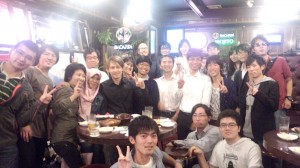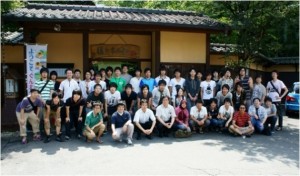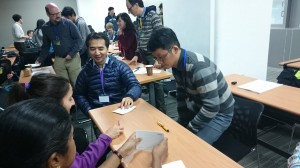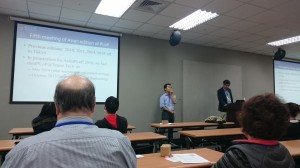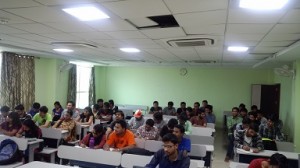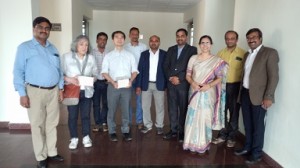Pablo Alejandro Quezada-Sarmiento, Juan Garbajosa, Liliana Pacheco-Jara, Hironori Washizaki, Liliana Enciso, “Curricular Design based in Bodies of Knowledge: Engineering Education for the Innovation and the Industry,” SAI Computing Conference 2016, July 13-15, 2016, London, UK. (to appear)
~JISX25051:2016リリース記念セミナー~ 世界最高基準を目指す日本のソフトウェア品質 3月29日
システム・ソフトウェアの品質要求および評価の国際規格SQuaREシリーズのISO/IEC 25051:2014の日本版JIS X 25051:2016「既製ソフトウェア製品に対する品質要求事項及び試験に対する指示」(予定)のリリースを記念して、グローバルスタンダードに基づいてソフトウェア製品の品質を体系的に測定評価する方法とその基準を、同国際規格策定エディタ・プロジェクトリーダより詳しくご紹介するセミナーを3月29日に開催します。またセミナーでは、IPA RISE委託研究として早稲田大学がCSAJとの協力のもとで製品募集を開始したISO/IEC 25051:2014(JIS X 25051:2016)に基づくソフトウェア製品の品質実態調査について詳しくご紹介します。同品質実態調査は、CSAJにおけるPSQ認証も兼ねるものとなっています。さらにパネル討論では、今後の世界最高基準を目指した日本のソフトウェア製品の品質のあり方を、会場と共に議論します。参加費無料です。ぜひご参加ください。
情報理工学科 鷲崎研究室オープンハウス 2016年3月21-23, 25日
以下の日程で63号館5階0523室にてオープンハウスを開催しますので興味があればぜひ遊びに来てください。また期間中に限らず研究内容や生活等に関して疑問点があれば気軽にwashizaki[at]waseda.jpまで質問してください。期間外の立ち寄りもOKです。配属決定後の顔合わせは31日13:00以降を予定しています。
研究キーワード: プログラミング言語・環境、ソフトウェア要求・設計・モデリング・再利用、ソフトウェア品質保証・セキュリティ、IoT/クラウドシステム分析・設計・実装、組織目標・戦略、システム・ソフトウェア開発マネジメント、情報システム・プログラミング教育
3月21日(月)14:40-18:30
3月22日(火)10:00-18:00
3月23日(水)10:00-18:00
3月25日(金)10:00-18:00
AsianPLoP 2016 was successfully held in Taipei on Feb 24-26.
AsianPLoP 2016: 5th Asian Conference on Pattern Languages of Programs was successfully held in Taipei on Feb 24-26. YC and I as co-organizers organized the conference. Thanks to the organizer YC, all shepherds/reviewers, supporters, sponsors, authors and participants! At the conference, we had two great keynotes, one invited talk, three focused groups, and Writer’s Workshops! 17 pattern and pattern language papers have been successfully workshopped. Moreover we had nice social events including games and banquet for meeting together, strengthening our network, and having fun! See you next time 2017, at somewhere in Asia.
Pairwise Coverage-based Testing with Selected Elements in a Query for Database Applications, accepted at IWCT 2016.
Koji Tsumura, Hironori Washizaki, Yoshiaki Fukazawa, Keishi Oshima, Ryota Mibe, “Pairwise Coverage-based Testing with Selected Elements in a Query for Database Applications,” 5th International Workshop on Combinatorial Testing (IWCT 2016), collocated with ICST 2016, Chicago, USA, April 10, 2016. (to appear)
Because program behaviors of database applications depend on the data used, code coverages do not effectively test database applications. Additionally, test coverages for database applications that focus on predicates in Structured Query Language (SQL) queries are not useful if the necessary predicates are omitted. In this paper, we present two new database applications using Plain Pairwise Coverage (PPC) and Selected Pairwise Coverage (SPC) for SQL queries called Plain Pairwise Coverage Testing (PPCT) and Selected Pairwise Coverage Testing (SPCT), respectively. These coverages are based on pairwise testing coverage, which employs selected elements in the SQL SELECT query as parameters. We also implement a coverage calculation tool and conduct case studies on two open source software systems. PPCT and SPCT can detect many bugs, which are not detected by existing test methods based on predicates in the query. Furthermore, the case study suggests that SPCT can detect bugs more efficiently than PPCT and the costs of SPCT can be further reduced by ignoring records filtered out by the conditions of the query.
GO-MUC: A Strategy Design Method Considering Requirements of User and Business by Goal-Oriented Measurement, accepted at CHASE 2016.
Chihiro Uchida, Kiyoshi Honda, Hironori Washizaki, Yoshiaki Fukazawa, Kentaro Ogawa, Tomoaki Yagi, Mikako Ishigaki, Masashi Nakagawa, “GO-MUC: A Strategy Design Method Considering Requirements of User and Business by Goal-Oriented Measurement,” 9th International Workshop on Cooperative and Human Aspects of Software Engineering (CHASE 2016), short paper, collocated with ICSE 2016, Autin, Texas, USA, May 16, 2016. (to appear)
When developers operate a service, both the business objectives and users’ requirements must be satisfied. However, the interest between a business strategy and an action for the users is often
unclear. Moreover, users’ requirements that are inferred from user data analysis may not correspond with users’ real requirements. In this paper, we propose the GO-MUC method (Goal-oriented Measurement for Usability and Conflict) and apply it to Yahoo!Crowdsourcing. The GO-MUC method can develop a strategy considering requirements of both the user and the business. Our results validate this method; this method can find an interest between the business side and users side and plan more effective and user-friendly strategies to resolve a conflicting interest.
Case Study: Software Reliability Growth Model Based on Person Hours, accepted as poster at IWESEP 2016.
Kiyoshi Honda, Nobuhiro Nakamura, Hironori Washizaki and Yoshiaki Fukazawa, “Case Study: Software Reliability Growth Model Based on Person Hours,” 7th IEEE International Workshop on Empirical Software Engineering in Practice (IWESEP), poster, Osaka, March 13, 2016. (to appear)
Software reliability growth models (SRGMs) have been proposed and applied in the past few decades. SRGMs are models which describe the relations between faults and faults’ detected times and predict the numbers of faults will be detected. Recently SRGMs are applied in calendar time. However, calendar time contains many kinds of times when developers do nothing, for example, holidays, stopping testing, working overtime and so on. It means that the calendar time does not reflect strict efforts of development. In principle of SRGMs, the detected time is based on developers’ operating time in testing phase. If developers use calendar time to a SRGM, the SRGM produces inaccurate results and confuses the developers. We assume that person hours would be a well approximation of developers’ operating time and make the results of the SRGMs more accurate than calendar time because person hours reflect strict efforts of development. We compare the fitness of SRGMs which are based on calendar time and person hour. Additionally, we propose a method to compare SRGMs across projects based on the fault density and the rate of person hours. In this paper, we apply our proposal method to the data sets which belong to nine projects which are developed by Sumitomo Electric Industries, Ltd. with a same framework. Using the nine projects data, we obtain the results which explain SRGMs based on person hours are well fitting than SRGMs based on calendar time.
Prof. Washizaki provided a one-week special lecture course on Software Quality Assurance at Indian Institute of Information Technology, Design and Manufacturing (IIITDM) Jabalpur from 14 to 19 Feb 2016.
Within the framework of Japan-India Research and Education Collaboration initiated by former Prime Minister Koizumi in 2005, Prof. Washizaki provided a one-week special lecture course on Software Quality Assurance at Indian Institute of Information Technology, Design and Manufacturing (IIITDM) Jabalpur from 14 to 19 Feb 2016. The course covered most of basic and practical techniques including software review, testing and measurement. Thanks to warm welcom and kind supports, kProf. Washizaki enjoyed much the lecture course together with host faculty member and students, and agreed about further research collaboration with Prof. Atul at IIITDM-J.
Learning Effectiveness of Team Discussions in Various Software Engineering Education Courses, accepted as short paper at CSEE&T 2016 (CORE Rank C)
Masashi Shuto, Hironori Washizaki, Katsuhiko Kakehi, Yoshiaki Fukazawa, Shoso Yamato, Masashi Okubo, “Learning Effectiveness of Team Discussions in Various Software Engineering Education Courses,” Proceedings of the 29th IEEE Conference on Software Engineering Education and Training, short paper, Dallas, USA, April 5-6, 2016. (CORE Rank C)(to appear)
One effective method for students to learn skills necessary for software intensive development is to work in teams to complete software tasks. Previously we examined the educational effectiveness as a function of personal characteristics, but the findings were inconclusive. This study investigates the influence of team discussions on learning effectiveness in various types of software engineering education courses. Because we hypothesize that team discussions impact learning and are related to educational effectiveness, we asked students to answer questionnaires inquiring about how much students contribute to discussions. As a result, the relationship between learning effectiveness and the number of comments during a discussion, which may be explained by personal characteristics, is discovered. Additionally, upon comparing two learning courses (a system development course and a IT management course), two antithetical results are elucidated. We expect that this research will help improve the effectiveness of educators leading student team discussions.
How Are Effective Combinations of Personal Characteristic types different in Controlled Project-Based Learning Courses?, accepted as short paper at CSEE&T 2016 (CORE Rank C)
Yusuke Sunaga, Masashi Shuto, Hironori Washizaki, Katsuhiko Kakehi, Yoshiaki Fukazawa, Shoso Yamato, Masashi Okubo, “How Are Effective Combinations of Personal Characteristic types different in Controlled Project-Based Learning Courses?,” Proceedings of the 29th IEEE Conference on Software Engineering Education and Training, short paper, Dallas, USA, April 5-6, 2016. (CORE Rank C)(to appear)
To improve practical IT education, many universities are implementing project-based learning (PBL). Although researchers have examined the relationship between projects and personality, they have not investigated the type of projects and team construction based on personality. We consider not to construct optimal team for the view of educational effectiveness if we do not understand the difference of each course characteristic. Herein the Five Factor & Stress theory is used to measure personal characteristics and classify students enrolled in two different PBL courses at a university into four types – leadership, management, tugboat, and anchor. Then knowledge and skills questionnaires are used to measure educational effectiveness. The results show that educational effectiveness is highest when a team consists of management and anchor types but not leadership types in the PBL course which teaches system development, and a team without management types is consisted in the PBL course which teaches IT management strategy.
